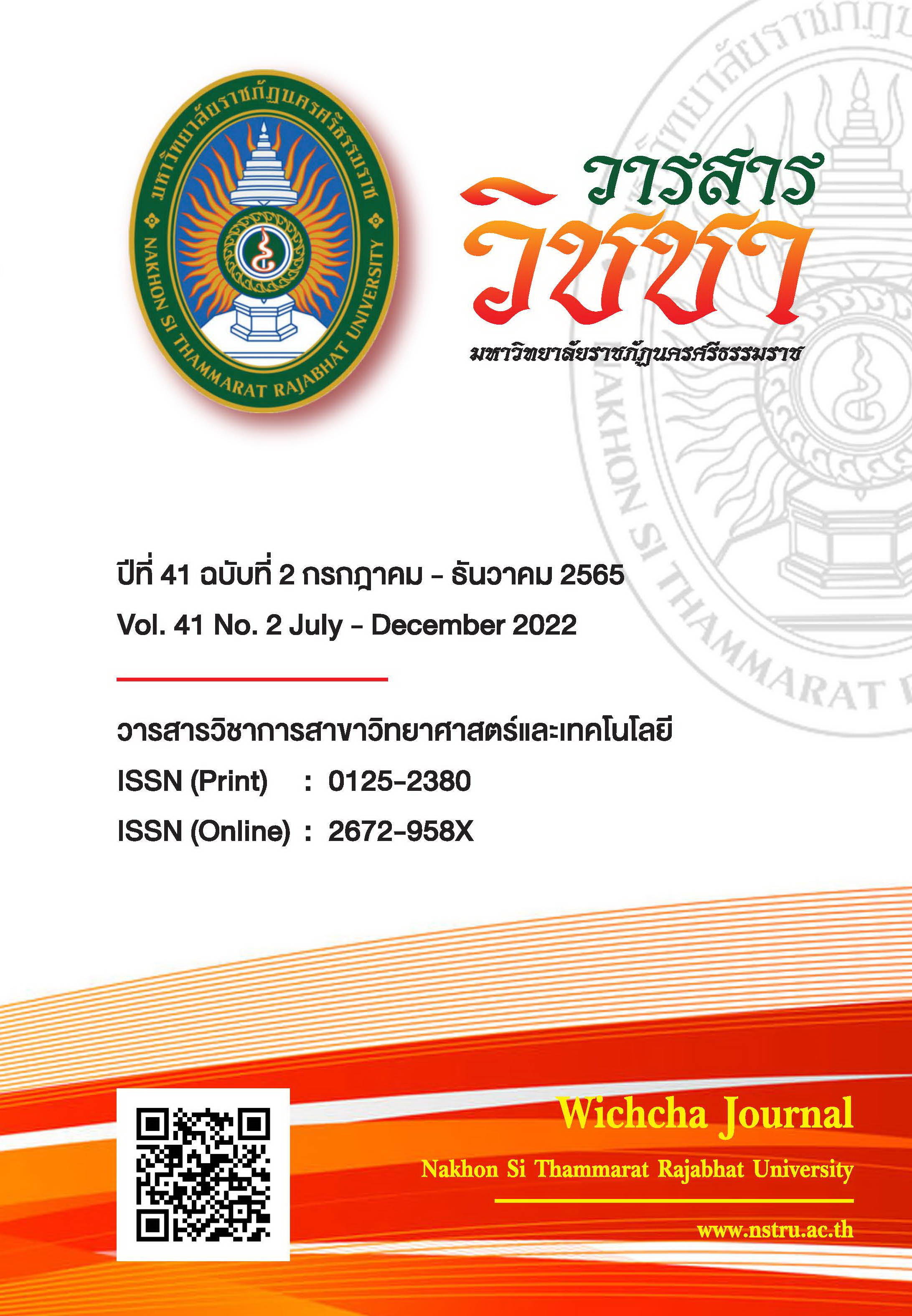การเปลี่ยนแปลงชีพลักษณ์ของต้นประ (Elateriospermum tapos) บริเวณเส้นทางศึกษาธรรมชาติที่มีภูมิประเทศแตกต่างกันในอุทยานแห่งชาติเขานัน จังหวัดนครศรีธรรมราช
Main Article Content
บทคัดย่อ
ต้นประ (Elateriospermum tapos) เป็นไม้ต้นที่พบเฉพาะในภาคใต้ของประเทศไทย ซึ่งสามารถนำเมล็ดประมาใช้ประโยชน์ในการแปรรูปเป็นอาหารได้หลายชนิด ต้นประจะมีชีพลักษณ์เปลี่ยนแปลงไปตามฤดูกาลโดยปัจจัยหลักที่มีผลต่อชีพลักษณ์ คือ การได้รับแสงของเรือนยอดซึ่งมีผลต่อการแตกตายอดและการเปลี่ยนสีใบ วัตถุประสงค์ในการศึกษาครั้งนี้เพื่อศึกษาชีพลักษณ์ของต้นประในพื้นที่อำเภอนบพิตำและอำเภอท่าศาลา จังหวัดนครศรีธรรมราช ซึ่งขึ้นอยู่ในสภาพภูมิประเทศที่มีผลต่อการได้รับแสงของเรือนยอดที่แตกต่างกัน โดยใช้ตัวอย่างต้นประที่ขึ้นตลอดพื้นที่เส้นทางศึกษาธรรมชาติห้วยเลขในอำเภอนบพิตำ (ระดับความสูงจากน้ำทะเลประมาณ 285 เมตร ความชันเฉลี่ย 30 องศา) และเส้นทางศึกษาธรรมชาติหินท่อในอำเภอท่าศาลา (ระดับความสูงจากน้ำทะเลประมาณ 455 เมตร ความชันเฉลี่ย 45 องศา) เป็นตัวแทนในการศึกษาเส้นทางละ 40 ต้น จากนั้นศึกษาชีพลักษณ์เดือนละ 1 ครั้ง รวม 12 เดือน โดยเก็บข้อมูลการเปลี่ยนสีใบ การออกดอก การติดผล และน้ำหนักเมล็ด ผลการศึกษาพบว่าชีพลักษณ์ของต้นประมีการเปลี่ยนแปลงที่แตกต่างกันตามลักษณะภูมิประเทศที่ทำให้เรือนยอดของต้นประรับแสงต่างกัน โดยพื้นที่ศึกษาทั้งสองพื้นที่มีช่วงเวลาการเปลี่ยนแปลงชีพลักษณ์เหลื่อมกัน 1 เดือน ดังนั้นจึงควรมีการศึกษาเพิ่มเติม เช่น การวัดปริมาณแสงบริเวณเรือนยอดเพื่อให้ได้ข้อมูลที่ละเอียดยิ่งขึ้น ด้านปริมาณผลผลิตของเมล็ดประพบว่าทั้งสองพื้นที่มีปริมาณผลผลิตที่ไม่แตกต่างกัน การศึกษาครั้งนี้มีข้อแนะนำว่าควรมีการกำหนดช่วงเวลาในการเก็บผลผลิตในแต่ละพื้นที่เพื่อให้มีการใช้ประโยชน์จากต้นประได้อย่างยั่งยืน
Article Details

อนุญาตภายใต้เงื่อนไข Creative Commons Attribution-NonCommercial-NoDerivatives 4.0 International License.
เนื้อหาและข้อมูลในบทความที่ลงตีพิมพ์ในวารสารวิชชา มหาวิทยาลัยราชภัฏนครศรีธรรมราช ถือเป็นข้อคิดเห็นและความรับผิดชอบของผู้เขียนบทความโดยตรง ซึ่งกองบรรณาธิการวารสารไม่จำเป็นต้องเห็นด้วยหรือร่วมรับผิดชอบใด ๆ
บทความ ข้อมูล เนื้อหา รูปภาพ ฯลฯ ที่ได้รับการตีพิมพ์ในวารสารวิชชา มหาวิทยาลัยราชภัฏนครศรีธรรมราช ถือเป็นลิขสิทธ์ของวารสารวิชชา มหาวิทยาลัยราชภัฏนครศรีธรรมราช หากบุคคลหรือหน่วยงานใดต้องการนำข้อมูลทั้งหมดหรือส่วนหนึ่งส่วนใดไปเผยแพร่ต่อหรือเพื่อการกระทำการใด ๆ จะต้องได้รับอนุญาตเป็นลายลักษณ์อักษรจากวารสารวิชชา มหาวิทยาลัยราชภัฏนครศรีธรรมราชก่อนเท่านั้น
The content and information in the article published in Wichcha journal Nakhon Si Thammarat Rajabhat University, It is the opinion and responsibility of the author of the article. The editorial journals do not need to agree. Or share any responsibility.
เอกสารอ้างอิง
จุฑามาศ ศุภพันธ์ วีระเกียรติ ทรัพย์มี วรวิทู มีสุข จุติพร อัศวโสวรรณ ปะกิต ไชยธาดา เบญจพร จันทรโคตร จรัญ ด้วงแป้น พัฒนพร รินทจักร พินิดา งามไตรไร และอธิวรรธน์ บุญฤทธิ์. (2563). ลักษณะทางชีววิทยา ความหลากหลายทางพันธุกรรม และรูปแบบการกระจายพันธุ์ของต้นประในพื้นที่อำเภอนบพิตำ จังหวัดนครศรีธรรมราช. รายงานวิจัย. นครศรีธรรมราช.
ปริญญา หม่อมพิบูลย์ วันดี แก้วสุวรรณ อนุรักษ์ ตรีเพ็ชร และธราดล วัฒนนาวิน. (2561). แนวทางการพัฒนาเทคโนโลยีการแปรรูปผลิตภัณฑ์จากเมล็ดประในเชิงพาณิชย์. วารสารวิชชา มหาวิทยาลัยราชภัฏนครศรีธรรมราช, 37(พิเศษ), 113-128.
มานพ แก้วชัด ณรงค์ รักเคี่ยน วัชรพงศ์ ศรีแสง และศิริลักษณ์ ชุมเขียว (2550). ผลกระทบของการเปลี่ยนแปลงภูมิอากาศต่อต้นประ. รายงานวิจัย. นครศรีธรรมราช.
วิสุทธิ์ ใบไม้ และรังสิมา ตัณฑเลขา. (2550). เขานัน-ป่าเมฆธรรมชาติกับภาวะโลกร้อน. กรุงเทพฯ: กรุงเทพฯ จำกัด.
Borchert, R. (1994). Soil and stem water storage determine phenology and distribution of tropical dry forest trees. Ecology, 75(5), 1437-1449, doi: https://doi.org/10.2307/1937467.
Charoensuk, A., Jaroensutasinee, M., Srisang, W. and Jaroensutasinee, K. (2012). Parah forest clusters at Khao Nan national park, Thailand. Walailak Journal of Science and Technology, 9(4), 475-480, doi: https://doi.org/10.2004/wjst.v9i4.363.
Charoensuk, A., Tina, F.W., Jaroensuthasinee, M. and Jaroensutasinee, K. (2018). Predation and dispersal of Parah tree (Elateriospermum tapos) seeds by red spiny rats (Maxomys surifer) in Khao Nan national park. Journal of Environmental Biology, 39(1), 23-29, doi: https://doi.org/10.22438/jeb/39/1/MRN-588.
Chumkiew, S., Srisang, W., Jaroensutasinee, K. and Jaroensutasinee, M. (2007). Phenology of the Parah tree (Elateriospermum tapos) using a GAPS model. World Academy of Science, Engineering and Technology, 32, 207-211.
Cranbrook, E. and Edwards, D.S. (1994). A tropical rainforest: The nature of biodiversity in Borneo at Belalong, Brunei. London: The Royal Geographical Society and Sun Tree Publishing.
dos Santos, G.F., Kuster, V.C., Silva, A.F.M., Faria, A.P. and Moreina, A.S.F.P. (2021). Changes in color during leaf development of Eugenia uniflora (Myrtaceae): Different strategies for integrity conservation of the photosynthetic aaparatus. Australian Journal of Botany, 69(4), doi: https://doi.org/10.1071/BT20145.
Google Earth. (2020). Google Earth. Retrieved 23 June 2020, from: https://www.google.com/earth/.
Jantarit, S., Wattanasit, S. and Sotthibandhu, S. (2009). Canopy ants on the briefly deciduous tree (Elateriospermum tapos Blume) in a tropical rainforest, southern Thailand. Songklanakarin Journal of Science and Technology, 31(1), 21-28.
Kuhapong, U., Sornkliang, W., Sookkhathon, W., Thaiphan, R., Jaroensutasinee, M. and Jaroensutasinee, K. (2011). A study of Parah (Elateriospermum tapos) phenology at park renger station 5 Hui Lek. Wichcha journal Nakhon Si Thammarat Rajabhat University, 30(1), 13-19.
Ma, Y., Li, X., Gu. Z. and Li, J. (2019). Leaf color and growth change of Sedum rubrotinctum caused by two commercial chemical products. Hort Science, 54(3), 434-444, doi: https://doi.org/10.21273/HORTSCI13557-18.
Medway, L. (1972). Phenology of a tropical rain forest in Malaya. Biological Journal of Linnean Society, 4(2), 117-146, doi: https://doi.org/10.1111/j.1095-8312.1972.tb00692.x.
Niinemets, U., Kull, O. and Tenhunen, J.D. (1999). Varieability in leaf morphology and chemical composition as a function of canopy light environment in coexisting deciduous trees. International Journal of Plant Sciences, 160(5), 837-848, doi: https://doi.org/10.1086/314180.
Osada, N., Takera, H., Furukawa, A. and Awang, M. (2002). Ontogenetic changes in leaf phenology of a canopy species, Elateriospermum tapos (Euphoriaceae), in a Malaysian rain forest. Tropical Ecology, 18(1), 91-105.
Paker, G.G. (1995). Structure and microclimate of forest canopies. In Lowman, M.D. and Nadkarni, N.M. (Eds.). Forest canopy, pp. 73-106. California: Academic Press.
Reich, P.B. and Borchert, R. (1982). Phenology and ecophysiology of the tropical tree, Tabebuia neochrysantha (Bignoniaceae). Ecology, 63(2), 294-299.
Reich, P.B. and Borchert, R. (1984). Water stress and tree phenology in a tropical dry forest in the lowlands of Costa Rica. Journal of Ecology, 72(1), 61-74, doi: https://doi.org/10.2307/2260006.
Riha, S.J., Rossiter, D.G. and Simoends, P. (2003). GAPS: General purpose atmosphere-plant-soil simulator. New York: Cornell University.
Suppapan, J., Supmee, V. and Rinthajak, P. (2021). Genetic diversity of Parah tree (Elateriospermum tapos) in Nopphitum district, Nakhon Si Thammarat province. Phranakhon Rajabhat Research Journal (Science and Technology), 16(1), 115-126.
Whitmore, T. C. (1972). Euphorbiaceae. In Whitmore, T.C. (Ed.). Tree flora of Malaya volume 2, pp. 34-136. Kuala Lumpur: Longman.


